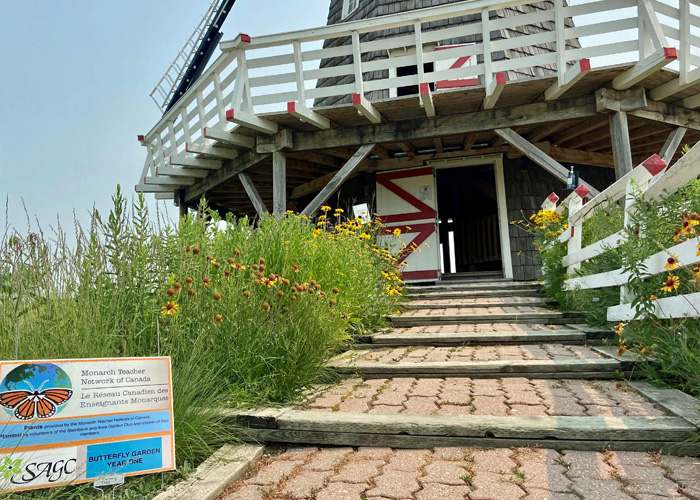Village News
The Butterfly Effect

Editor’s note from Gary Dyck: Last week I shared about the Mennonite Heritage Village’s (MHV) partnership with the Steinbach Regional Secondary School and their photo essay exhibit. This week we highlight part of partnership with the Steinbach and Area Garden Club. MHV is thankful for the great landscaping they provide on our grounds. You can now visit our grounds and enjoy the beauty of their work and the Monarch butterflies that they write about below!
The Butterfly Effect theory suggests that a small movement like a flutter of a butterfly wing can result in a significant difference in future life events. The Steinbach and Area Garden Club saw this theory put into action on March 9, 2020 when Cathy Shulak from the Monarch Teacher Network of Canada spoke to the membership about the status of Monarch butterflies and the importance of bees and other pollinators for our food sources. As we watched the Monarch Butterfly wings flutter across the presentation screen, we learned that Monarch Butterflies are now on the world’s Endangered Species list and that Milkweed plants are essential for Monarch butterfly reproduction.
Within two months, the Steinbach and Area Garden Club had resolved to create a Butterfly Garden to help save Monarch butterflies and to provide an attractive habitat for all pollinators. We created partnerships with the Mennonite Heritage Village who would host this Butterfly Garden and with the Monarch Teacher Network of Canada who would provide the funding to purchase plants. Just two weeks after planting the garden, Monarchs began to reproduce on our milkweeds. What a beautiful example of the Butterfly Effect Theory in action!
One year later… the Swamp Milkweeds planted in the MHV Butterfly Garden are thriving and hosting many Monarch butterfly caterpillars who are munching away on their leaves. In addition, other native plants provide a food source for a variety of other butterflies, bees, beneficial insects and birds.
The MHV Butterfly Garden is one example of the Steinbach and Area Garden Club and Mennonite Heritage Village efforts to be good stewards of nature and our land. By selecting native plants, not only are we able to reduce the amount of water needed to sustain healthy, beautiful plants, we are supporting our pollinators’ efforts to do their work. Of course, the flowers have the added benefit of colourful blossoms that take turns showing off their beauty from June to September.
The foot of the Windmill is the perfect setting for the Butterfly Garden! The Windmill serves as the final stage of human food production in the grain growing process. Although most of our grain crops are wind-pollinated, 80 percent of all flowering plants are pollinated primarily by insects. Of these, 87 of our leading food crops worldwide profit from the work of these pollinators. Truly these beneficial insects are critical in our agricultural past, present and future. And as the theory goes, when a butterfly flutters its wings in Steinbach a chain of events may well lead to rain falling in drought ravaged California, which in turn produces more food for us.




